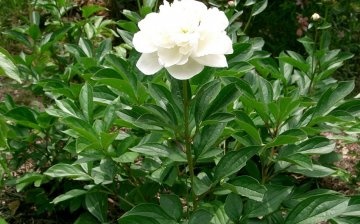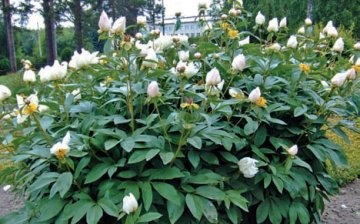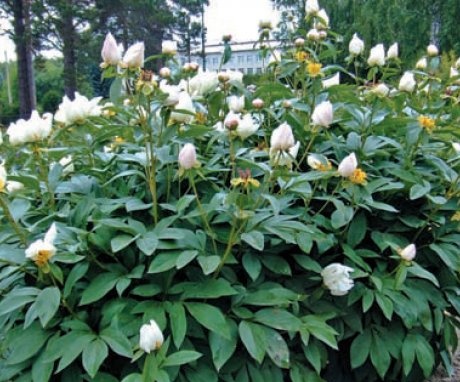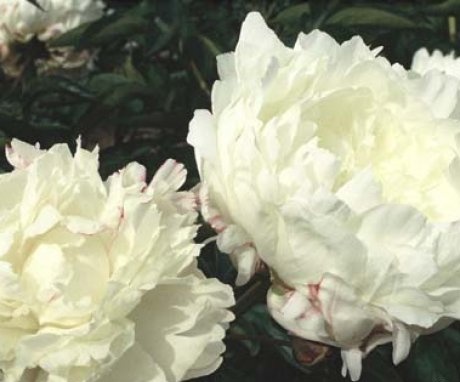Milk peony: growing rules for garden decoration and as a folk remedy
Milk-flowered peony came to us from China, in its homeland it is a national flower. Even in the period BC, the peony was famous for its medicinal properties, decoctions and infusions from seeds and rhizomes help with many diseases.
Content:
- Peony description
- Milk-flowered peony care
- Growing features
- Reproduction and use in traditional medicine
Peony description
Milk-flowered peony is a perennial shrub up to 1 meter high. It has large, highly dissected leaves with a shiny surface. The roots are large and fleshy, sometimes growing to such an extent that they protrude above the ground.
The peony begins to bloom in mid-June and ends in mid-July.
The color of flowers is varied: white, pink, red, the structure of the flower itself is also different, various shapes and surfaces (double and non-double). The diameter of the flowers is from 9 to 20 cm, they have a pleasant fragrant aroma. Several flowers grow on one stem.
The main properties of the peony are its drought resistance. Peony lactobacillus has a large number of varieties and hybrids.
Milk-flowered peony care
Although the peony is milky-flowered popular gardeners, there may be some problems when growing it that you need to be aware of. A peony can grow and develop rapidly, however, if it has not bloomed, then not all conditions are met.
Peonies do not like:
- Sandy or uncultivated soils.
- Waterlogged soils (in this case, the roots may rot).
- Shade (the plant tolerates shade, but does not bloom).
- Deep or shallow landing.
- Separation of too large bushes during reproduction.
- Transplanting without dividing.
- Development in one place on the site for over 8 years.
- Transplanting too often.
- Division of young bushes.
- Lack of moisture during the budding period of renewal and bud formation (in the second half of summer, abundant watering is required, for one bush about 10 liters of water).
- Over-saturation with mineral fertilizers (vegetative growth will be activated, but this will be to the detriment of the development of buds).
- More than half of the flowers are cut.
- Early cutting of the aboveground part of the bush (before September).
Growing features
Milk-flowered peony prefers loamy soils, needs good drainage and aeration. A peony will have an extremely negative reaction to damp or swampy soils. If groundwater passes under the land plot at a distance of less than 90 cm, then special measures will be required for planting bushes. For example, you can make a high bed or arrange drainage ditches.
Not suitable for growing peony and acidic soils, if there is such a problem, then it can be solved with the help of liming.
About 250 grams of lime is added to each planting hole, so in one area you can grow plants that suit different types of soil, choosing the conditions for each:
- The milkweed peony loves lighted places. Although the bush will develop successfully both in partial shade and in the shade, but this may affect the lack of flowering.
- The peony does not require special care, it can be attributed to unpretentious plants. Once a year, in the spring, it is necessary to loosen the ground and apply top dressing three times a year:
- First time in mid-May, using 50 grams of urea per bucket of water.
- The second time at the beginning of summer with urea with the addition of micronutrient fertilizer (this must be done before flowering).
- The third time after the plant has faded, apply micronutrient fertilizers.
When autumn comes, before the frost begins, you need to have time to cut the foliage along with the stems.
If the foliage is strong and holds well, then you can not cut it off, but simply cover it for the winter. After a couple of years, the peony will not even need a cover, the adults are famous for their good frost resistance. To be on the safe side, it will be enough to sprinkle the peony bush with wood ash, only 3 handfuls for the whole plant.
The peony is easily infested with the following pests:
- Ants.
- Green bronze.
- Rape flower beetles.
- Leaf and root nematodes.
The leaves can be attacked by:
- Spotting.
- Rot of roots and stems.
- Rust.
- Gray rot.
Reproduction and use in traditional medicine
Propagate a peony milk-flowered can be vegetatively, or to be more precise - by dividing the bush. The division is carried out from mid-August to mid-September. Young bushes cannot be taken, the peony must be up to 4 years old.
The breeding operation starts with:
- Foliage pruning, then the bush is dug in around the entire diameter at a distance of 10 cm from the trunk.
- Now the bush can be taken out and the roots are cleaned of the earth.
- Old roots can be safely removed, for transplanting you will need young and light ones, usually they are located at the edges.
- The optimum depth of the planting pit is 50-60 cm, manure should be laid on the bottom, then the nutrient mixture.
- This mixture is prepared from peat, humus and superphosphate.
- After that, you can lay the cut, but no more than 4-6 cm, the roots are well squeezed.
- If you plant a peony deep or shallow, then there is a chance that it will not bloom.
- After that, the roots are mulched with peat. In spring, mulch is harvested, but only after fresh sprouts have sprouted.
- The distance between the peonies should be at least 1 meter, if all planting conditions are met, then the shrubs will grow rapidly.
- You can not change the place of residence of a peony for about 10 years.
Gardeners plant peonies in rows, groups and singly.
It is possible to grow milk-flowered peony not only for decorative purposes, in Eastern medicine it is one of the most popular means.
Peony infusion is used for:
- Diseases of the heart and blood vessels
- For the prevention of ischemic heart disease
- To nourish blood and liver
- For the prevention of platelet aggregation
- To enhance immunity
- Provides analgesic and antipyretic effects
- Relieves pain and cramping
- When applied externally, it removes freckles and other pigmentation, and treats acne.
Milk-flowered peony distributed all over the world and is famous for its decorative properties, it is easy to propagate, it is unpretentious to care. In addition, the peony is a medicinal plant.
More information can be found in the video.
















